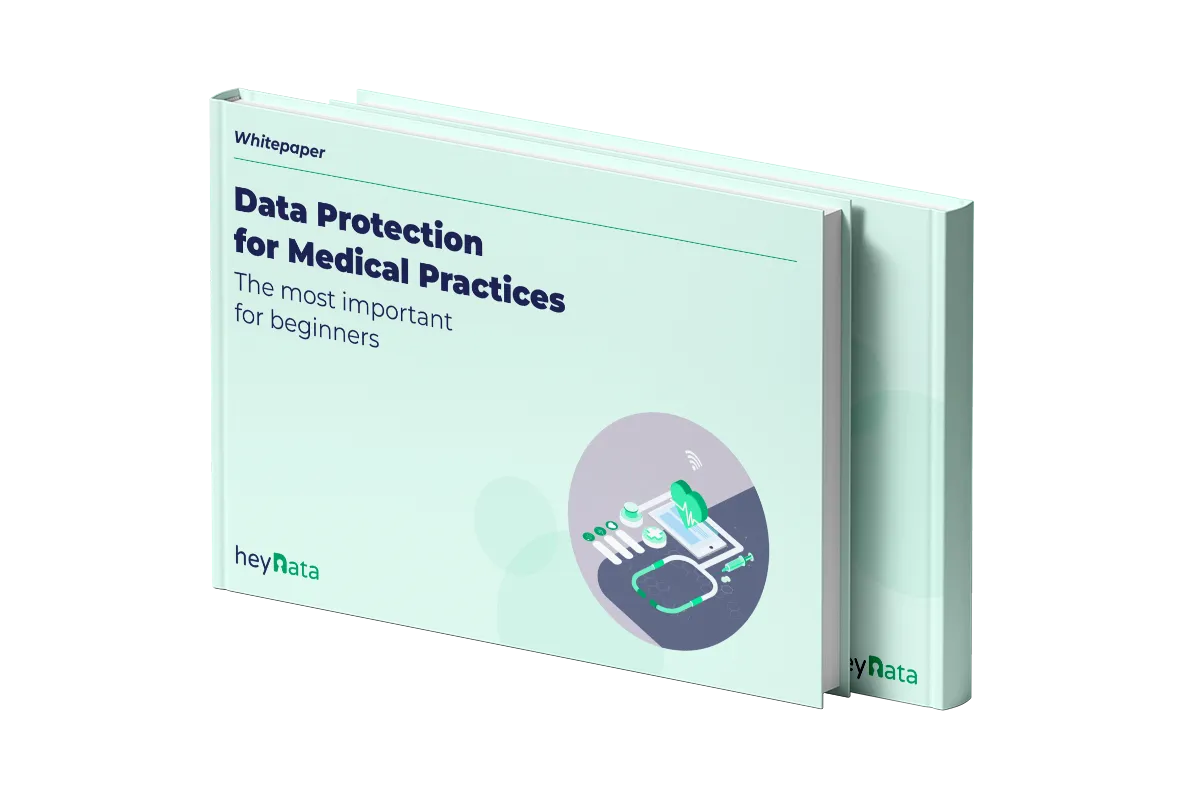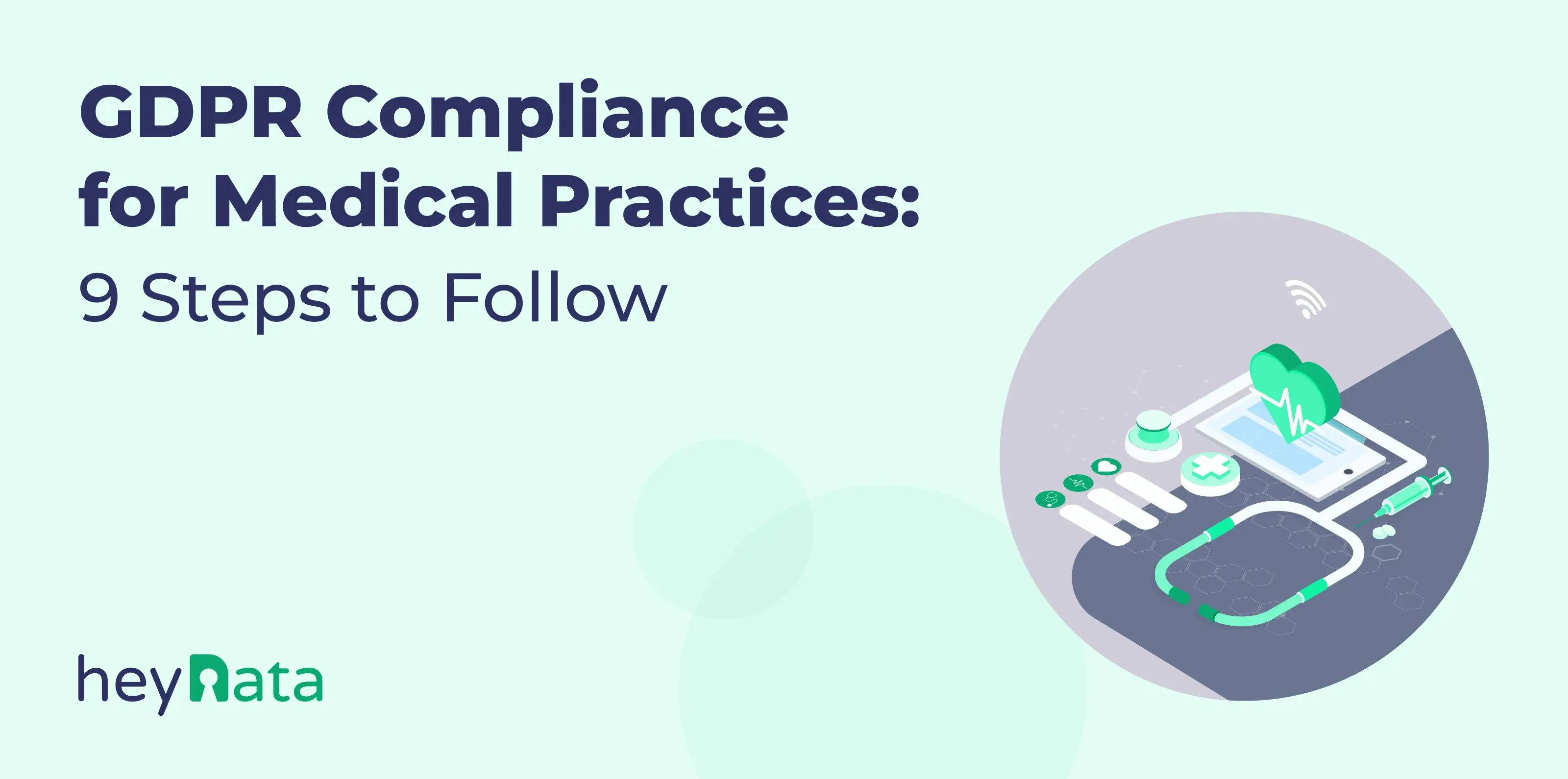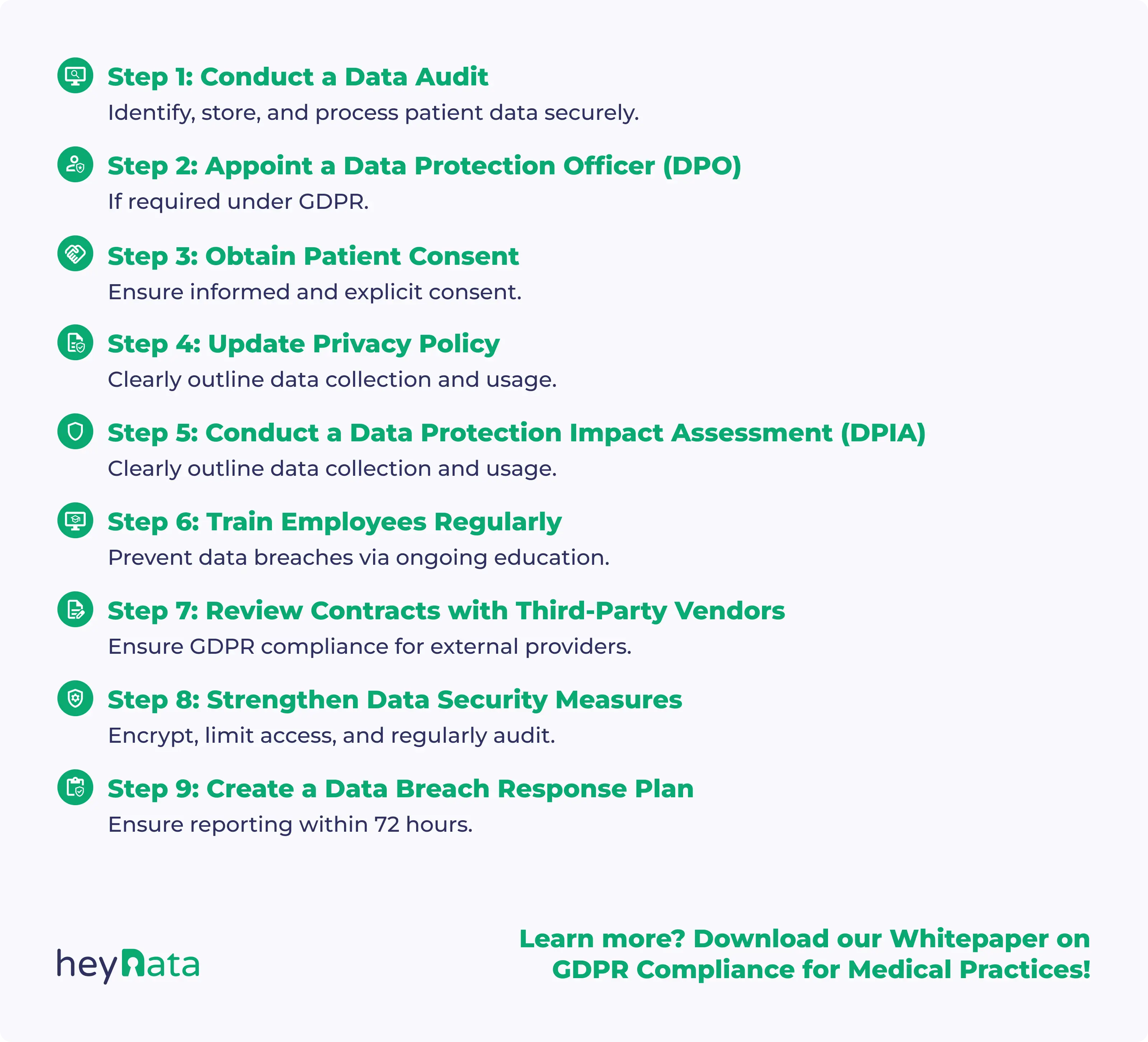
Stay compliant, avoid fines, and protect patient trust
Your ultimate GDPR guide for medical practices.

GDPR for Medical Practice: 9 Steps to Compliance

The General Data Protection Regulation (GDPR) significantly impacts medical practices.
Medical practices handle a lot of health data and are therefore required to adhere to strict data protection regulations. As such, you can expect a higher level of scrutiny by the authorities, including a risk of hefty fines.
However, aside from reducing the risk of fines, GDPR compliance also brings benefits including enhanced patient trust and confidence, as well as better data accuracy and decision-making thanks to proper data handling. While GDPR compliance does mitigate the risk of fines and enhances patient trust, it is primarily a legal obligation. Compliance is not optional for medical practices but a requirement under GDPR, particularly due to the processing of sensitive health data.
Has your medical practice taken the necessary steps to safeguard the data of its patients?
To ensure compliance, follow these nine steps.
Table of Contents:
1. Conduct a Data Audit
Conducting a data audit is the first step for medical practices to ensure compliance with GDPR regulations.
A comprehensive audit maps out your data processing activities to understand what data is collected, where it is stored and how it's processed. Documenting where, how, and why patient data is collected and processed establishes transparency and accountability.
Regular audits help confirm adherence to GDPR requirements as well as highlight potential risks in data management and processing.
To conduct a data audit, take these steps:
- Inventory Data: Catalog all types of personal data collected by the practice - this includes patient names, addresses, contact information, medical records, and any other sensitive information.
- Identify Data Flow: Map out how this data is collected, stored, and shared within the practice. This includes identifying the systems and platforms used for data processing and storage.
- Assess Consent Practices: Review how consent is obtained from patients for data collection and ensure it meets GDPR standards. Ensure consent forms are clear, specific, and easily accessible to patients.
- Identify Compliance Gaps: Recognize any areas where practices do not meet GDPR standards. This could range from improper data storage practices to inadequate data protection measures. Take note of these gaps and prioritize them for remediation.
By conducting regular data audits, medical practices can demonstrate their commitment to protecting patient data and complying with GDPR regulations. This not only helps build trust with patients but also safeguards the practice from potential legal and reputational risks.
In case you need assistance with this first crucial step of GDPR compliance, we are ready to help you with our thorough Data Protection Audit service.
2. Appoint a Data Protection Officer (DPO)
A Data Protection Officer (DPO) is legally required for all public authorities and all organizations that regularly monitor data subjects, or process large amounts of data.
The responsibilities of a DPO include:
- Monitoring data processing activities to ensure compliance
- Providing guidance on data protection obligations
- Serving as a contact point for individuals whose data is processed
- Assisting with training staff on data protection matters
As such, the role of a Data Protection Officer plays a crucial role in ensuring that medical practices comply with GDPR requirements.
A Data Protection Officer can be an internal staff member or an external consultant, depending on the size and complexity of the practice's data processing activities. It is important to ensure that the appointed DPO has expertise in data protection laws and practices, as they will be responsible for overseeing compliance efforts.
For many medical practices, hiring an external DPO can be advantageous. An external DPO brings specialized expertise and experience, allowing practices to focus on patient care while ensuring compliance with GDPR. Additionally, an external DPO can provide objective insights and help implement best practices tailored to the unique needs of the healthcare sector.
3. Obtain Patient Consent for Data Processing
In order to ensure compliance with GDPR, medical practices must obtain clear and informed consent from patients before processing their personal data. This means that patients should be fully aware of how their data will be used, who will have access to it, and the purpose for which it will be processed. Explicit consent is crucial, but not the only legal basis for processing health data under GDPR. Other lawful bases include medical necessity, healthcare provision, or legal obligations. It is important to determine the appropriate lawful basis depending on the circumstances.
Consent should be obtained through affirmative action, such as ticking a box or signing a consent form, and it should be freely given without any undue pressure or coercion.
Practices should also provide patients with the option to withdraw their consent at any time, as this is a fundamental right under GDPR.
It is essential for practices to maintain a record of each patient's consent, including the date and time it was obtained, as well as the specific information provided to the patient at that time.
Obtaining consent for data processing is also required on the website of your medical practice. Visitors need to understand what they are consenting to, which includes the types of data being collected, how it will be used, and any third parties with whom it may be shared.
This consent can be obtained via a cookie banner included in consent management platforms. Consent management platforms can help automate this process by:
- Managing cookie consent across all pages
- Documenting user preferences
- Automatically blocking or enabling cookies based on user choices
- Providing audit trails for compliance purposes
- Updating cookie notices when new tracking technologies are implemented
Popular consent management platforms include Usercentrics, CookieYes or consentmanager.

Stay compliant, avoid fines, and protect patient trust
Your ultimate GDPR guide for medical practices.
4. Ensure Online Compliance with an Up-to-Date Privacy Policy on Your Website
Having an up-to-date privacy policy on your medical practice’s website is crucial for GDPR compliance in the realm of digital healthcare.
This policy serves as a transparent declaration of how patient data is collected, used, and protected.
A comprehensive privacy policy should include:
- Data Collection Practices: Clear descriptions of what personal data is collected, including health information.
- Purpose of Data Processing: Explanation of why data is needed and how it will be utilized.
- Data Sharing Practices: Information on any third parties with whom patient data may be shared and the purpose of sharing.
- Patient Rights: Outline of patients' rights under GDPR, including their right to access, rectify, or erase their data.
If you need assistance updating your privacy policy, learn more about what a Privacy Policy should include or let us help you prepare a privacy policy tailored to your medical practice.
5. Conduct a Data Protection Impact Assessment (DPIA)
A Data Protection Impact Assessment (DPIA) is an essential process for identifying and reducing risks to patient data in healthcare services. It helps to identify, assess, and mitigate risks to patient data during its processing, whether it’s through electronic health records, appointment scheduling systems, or sharing data with third-party laboratories.
DPIA is particularly important for medical practices, as they handle large volumes of sensitive health information, which GDPR classifies as special category data due to its higher risk of misuse or harm if exposed. A DPIA helps ensure that such data is processed lawfully, transparently, and securely while minimizing risks like data breaches or unauthorized access.
To carry out a Data Protection Impact Assessment take these steps:
- Identify the Processing Activities: Start by identifying all processing activities that could pose a high risk to the rights and freedoms of patients.
- Assess Data Protection Risks: Evaluate the risk associated with these processing activities as well as their potential consequences.
- Develop Measures to Minimize Risks: Propose measures to reduce identified risks, including implementing enhanced security protocols and employee training programs.
- Document Results: Keep detailed records of the DPIA findings and actions taken to comply with GDPR requirements.
A DPIA is a critical part of GDPR compliance for medical practices. If you need help, our experts are happy to support you in conducting and implementing a successful DPIA.
6. Train Employees Regularly on Data Protection Practices
Regular training sessions on GDPR compliance are essential for all staff members in a medical practice. This training enhances staff awareness and ensures that employees understand their responsibilities regarding personal data handling.
Key areas of focus include:
- Data Handling Procedures: Staff must be well-versed in how to manage sensitive patient information, including proper storage, access controls, and secure sharing practices.
- Breach Response Protocols: Training should include steps to take when a data breach occurs. Understanding the correct response can mitigate potential damage and ensure compliance with GDPR notification requirements.
To facilitate effective learning, consider structured programs designed specifically for healthcare settings. At heyData, we offer comprehensive employee training tailored to meet GDPR standards in medical practices.
With a proactive approach to employee training, medical practices can significantly reduce the risk of data breaches and non-compliance with GDPR.
7. Review Contracts with Third-Party Providers Handling Patient Data
Medical practices increasingly rely on third-party providers for various services, such as electronic health record (EHR) platforms, diagnostic laboratories, and telemedicine services, all of which handle sensitive patient data and must comply with GDPR.
To ensure GPDR compliance of your vendors, it is essential to establish Data Processing Agreements (DPAs). A DPA is a legally binding contract between the medical practice and the third-party provider, outlining the responsibilities and obligations of each party regarding data protection according to the GDPR. In short, these agreements ensure that any vendor handling patient data complies with GDPR regulations, thus safeguarding sensitive information.
A DPA should include:
- Clear definitions of the roles and responsibilities of both the medical practice and the third-party provider in relation to data protection;
- Provisions for regular audits or assessments of the third-party provider's data security measures;
- Clauses ensuring that any sub-processors engaged by the third-party provider also comply with GDPR regulations;
- Procedures for handling data breaches or incidents, including notification requirements and timelines.
You can leverage Vendor Risk Management tools to further minimize the risk associated with third parties. These tools can quickly and reliably assess the security posture of potential vendors, helping you make informed decisions about which vendors to engage with, as well as ensuring their compliance with GDPR.
8. Enhance Data Security Measures to Protect Patient Information Against Breaches
Data security measures in healthcare are critical for protecting sensitive patient information. Implementing strong technical and organizational measures is essential to maintaining high-security standards and complying with GDPR.
Key security measures should include:
- Encryption: Encrypting patient data both at rest and in transit ensures that unauthorized individuals cannot access sensitive information. This is particularly important for electronic health records (EHRs) and during data transfers.
- Access Controls: Establish strict access controls to limit who can view or modify patient data. Role-based access ensures that only authorized personnel have access to specific information, reducing the risk of unauthorized exposure.
- Regular Audits: Conduct periodic audits to assess the effectiveness of existing security protocols. Regularly reviewing data handling practices helps identify vulnerabilities and areas for improvement.
By prioritizing these data security measures, medical practices can significantly reduce the risk of breaches and enhance the protection of patient information.
9. Prepare a Response Plan for Dealing with Potential Data Breach Incidents Effectively
A well-defined breach response plan is essential in the healthcare sector. This plan ensures that your medical practice can respond swiftly and effectively to any data breach incidents.
An effective response plan should include these components:
- Immediate Action Steps: Identify what to do first in the event of a breach, including containment measures to limit further exposure of patient data. This should include a clear outline of the roles and responsibilities of team members involved in the process.
- Incident Management Procedures: Establish clear protocols for assessing the severity of the breach, determining which patient information has been affected, and taking necessary corrective actions.
- Breach Notification Protocols: Under GDPR, organizations must notify affected individuals and relevant authorities without delay. Notifications should occur within 72 hours when feasible. In addition to notifying affected individuals and authorities, medical practices should also document all breaches, regardless of severity. GDPR requires organizations to maintain an internal record of data breaches, even if notification to the supervisory authority is not required. This ensures accountability and helps identify patterns to strengthen future data protection measures.
By implementing these strategies, medical practices can manage risk effectively while ensuring compliance with GDPR requirements.

Conclusion
With the steps outlined in this guide, medical practices can take proactive measures to protect patient data and comply with GDPR regulations.
While complete GDPR compliance can seem daunting, our All-in-One Compliance Solution makes compliance simple, allowing you to focus on what matters most - providing quality healthcare to your patients. Don't leave your practice vulnerable to data breaches and the potential consequences of non-compliance. Take action today and safeguard your patients' sensitive information.
Important: The content of this article is for informational purposes only and does not constitute legal advice. The information provided here is no substitute for personalized legal advice from a data protection officer or an attorney. We do not guarantee that the information provided is up to date, complete, or accurate. Any actions taken on the basis of the information contained in this article are at your own risk. We recommend that you always consult a data protection officer or an attorney with any legal questions or problems.


